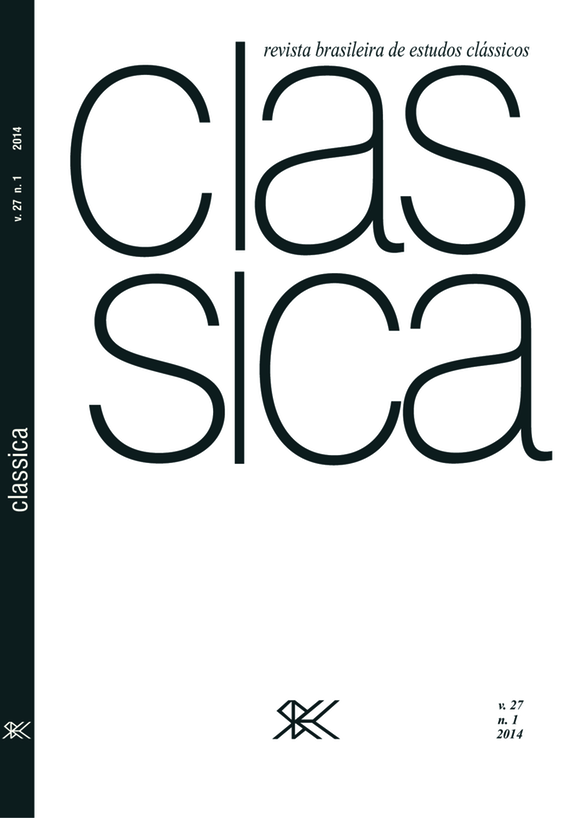Morte de Aemilius Paullus em Cana. Fazendo de herói um general derrotado (Polybius 3.112-117)
DOI:
https://doi.org/10.24277/classica.v27i1.339Palavras-chave:
Políbio, Historiografia, Canas, Aemilius Paullus.Resumo
Os estudiosos modernos consideram Políbio uma fonte confiável de informação (por exemplo, WALBANK, 1957, p.16 e LEHMAN, 1967). O principal tema de sua narrativa são os acontecimentos políticos e militares que moldaram a ascensão de Roma ao poder no mundo mediterrâneo; embora apenas porções das suas histórias sobreviveram, a sua superioridade em relação a outras fontes cobrindo este período é geralmente consensual. Em um estudo clássico, E. Marsden analisa Políbio como historiador militar e chegou à conclusão de que era um narrador preciso de eventos militares (MARSDEN, 1974, p. 270-71). Seu relato da batalha de Canas é um bom exemplo, à medida que considera a descrição do combate melhor do que os relatos de Tito Lívio, assim como outras fontes posteriores. A reputação de Políbio como um historiador preciso é bem merecida, e não é o objetivo deste artigo afirmar o contrário. Sua reputação é provavelmente a razão pela qual os historiadores modernos aceitam sua descrição da função de Aemilius Paullus na luta em Canas, apesar de algumas contradições e adições fictícias. Na verdade, uma análise detalhada da sua descrição da batalha mostra que o historiador grego, de fato, amplia o enaltecimento de Paullus, e que sua versão das ações do cônsul no campo de batalha deve ser rejeitada.
Downloads
Referências
BRISCOE, John. The Second Punic War. In: ASTIN, Alan Edgar; WALBANK Frank (Ed.). The Cambridge Ancient History. Cambridge: Cambridge University Press, 1989. v. VIII, p. 44-80.
BROUGHTON, Thomas Robert. The Magistrates of the Roman Republic. New York: American Philological Association, 1957. v. I.
BRUNT, Peter. Roman Manpower. Oxford: Oxford University Press, 1987.
CHAMPION, Craige B. Cultural Politics in Polybius’ Histories. Berkeley: University of California Press, 2004.
CONNOLLY, Peter. Greece and Rome at War. London: Greenhill, 1998.
DALY, Gregory. Cannae. The Experience of Battle in the Second Punic War. London: Routledge, 2002.
DE SANCTIS, Gaetano. Storia dei Romani. Roma: Fratelli Bocca, 1917. v. III.
DELBRÜCK, Hans. History of the Art of War (Vol. I). In: Warfare in Antiquity. Trad. W.J. Renfroe. Lincoln: University of Nebraska Press, 1990.
ECKSTEIN, Arthur M. Moral Vision in the Histories of Polybius. Berkeley: University of California Press, 1995.
EHRHARDT, Christopher. Speeches before battle?, Historia, v. 44, p. 120-121, 1995.
GOLDSWORTHY, Adrian. Cannae. London: Phoenix Press, 2001.
HANSEN, Mogens Herman. The Battle Exhortation in Ancient Historiography: Fact or Fiction? Historia, v. 42, p. 161-180, 1993.
HANSEN, Mogens Herman. The Little Grey Horse—Henry V’s Speech at Agincourt and the Battle Exhortation in Ancient Historiography. Histos, v. 4, electronic publication, 1998. Disponível em: www.dur.ac.uk/Classics/histos/1998/hansen.html.
LAZENBY, John. Hannibal’s War. Warminster: Aris and Phillips, 1978.
LEHMANN, Gustav Adolf. Untersuchungen zur historischen Glaubwürdigkeit des Polybios. Münster: Aschendorff, 1967.
MARINCOLA, John. Speeches in Classical Historiography. In: MARINCOLA John (Ed.). A Companion to Greek and Roman Historiography. Oxford: Blackwell, 2007. p. 118-132.
MARSDEN, Eric William. Polybius as a Military Historian. In: Polybe, Entretiens sur l’Antiquite Classique XX. Geneve: Fondation Hardt, 1974, p. 269-301.
MCCALL, Jeremiah. The Cavalry of the Roman Republic. London & New York: Routledge, 2002.
MCGING, Brian. Polybius’ Histories. Oxford: Oxford University Press, 2010.
OAKLEY, Stephen. A Commentary on Livy (Books VI-X). Oxford: Clarendon Press, 1997.
POLYBII. Historiae. Transl. Ludwig Dindorf and Theodor Büttner-Wobst. Munich: K. G. Saur, 1998.
SABIN, Philip. The Mechanics of Battle in the Second Punic War. In: CORNELL, Tim; RANKOV, Boris; SABIN, Philip (Ed.). The Second Punic War: a reappraisal. London: Institute of Classical Studies, 1996.
SABIN, Philip; Lost Battles. Reconstructing the Great Clashes of the Ancient World. London: Hambledon Continuum, 2007.
SABIN, Philip; Land Battles. In: SABIN, Philip; VAN WEES, Hans; WHITBY, Michael (Ed.). The Cambridge History of Greek and Roman Warfare. Cambridge: Cambridge University Press, 2007. v. I, p. 399-434.
SAUER, Hertha. Paludamentum, Realencyclopädie der classischen Altertumswissenschaft, v. 18, n. 3, cols. 281-86, 1949.
TOYNBEE, Arnold. Hannibal’s Legacy. London: Oxford University Press, 1965. v. 2.
VEITH, Georg; KROMAYER, Johannes. Antike Schlachtfelder in Italien und Afrika. Berlin, Weidmannsche Buchhandlung, 1912. v. 3, part 1.
VEITH, Georg; KROMAYER, Johannes. Antike Schlachtfelder. Berlin: Weidmannsche Buchhandlung, 1924-1931. v. 4.
WALBANK, Frank. A Historical Commentary to Polybius. Oxford: Oxford University Press, 1957. v. I.
WALBANK, Frank. Speeches in Greek Historians. In: WALBANK, Frank. Selected Papers: studies in Greek and Roman History and Historiography. Cambridge: Cambridge University Press, 1985. p. 242–261.
WOOTEN, Cecil. The Speeches of Polybius: an insight into the nature of Hellenistic Oratory. American Journal of Philology, v. 95, p. 235–51, 1974.
Downloads
Publicado
Edição
Seção
Licença
Autores que publicam nesta revista concordam com os seguintes termos:
a. Autores mantém os direitos autorais e concedem à revista o direito de primeira publicação, com o trabalho simultaneamente licenciado sob a Creative Commons Atribuição 4.0 Internacional (CC BY 4.0) que permite o compartilhamento do trabalho com reconhecimento da autoria e publicação inicial nesta revista.
b. Autores têm autorização para assumir contratos adicionais separadamente, para distribuição não-exclusiva da versão do trabalho publicada nesta revista (ex.: publicar em repositório institucional ou como capítulo de livro), com reconhecimento de autoria e publicação inicial nesta revista.
c. Autores têm permissão e são estimulados a publicar e distribuir seu trabalho online após o processo editorial (ex.: em repositórios institucionais ou na sua página pessoal), já que isso pode gerar alterações produtivas, bem como aumentar o impacto e a citação do trabalho publicado (Veja O Efeito do Acesso Livre).
d. Autores autorizam a cessão, após a publicação, de seu conteúdo para reprodução em indexadores de conteúdo, bibliotecas virtuais, bases de dados de acesso público e similares.











